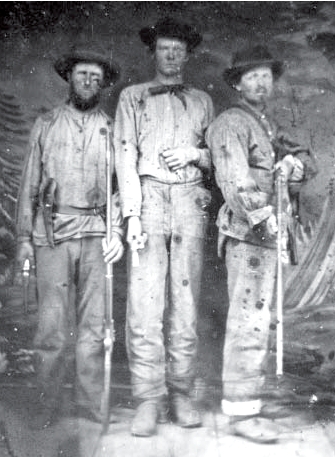By Tony O’ Bryan, University of Missouri—Kansas City
Event Summary:
- Date: August 15-16, 1862
- Location: Near Lone Jack, Jackson County, Missouri
- Adversaries: Union Maj. Emory Foster vs. Confederate regulars and bushwhackers
- Size of Forces: Approx. 800 Union soldiers vs. more than 1,500 Confederate soldiers
- Casualties: More than 100 killed, captured, or wounded on both sides
- Result: Confederate victory; Lone Jack virtually destroyed
The Battle of Lone Jack occurred in Jackson County, Missouri over the weekend of August 15-17, 1862, as a result of the Union attempting to wrest military control over the border region from the hands of the bushwhackers. In early 1862, Union commanders at posts in Pleasant Hill and Independence counted growing numbers of soldiers shot out of their saddles, wounded, or disappeared while on patrol. In April, the local insurrection so disrupted federal mail, communications, and travel that Union command in Jackson County was effectively isolated from the rest of the state. The Sni Valley, a rugged topography extending north of the community of Lone Jack toward the Missouri River, was a particularly troublesome area for Union troops.
Clemency: Major Foster was briefly captured, but according to contemporary reports, the later-to-be-famous outlaw Cole Younger saved him from a threatened summary execution.
On August 11, 1862, the bushwhackers shocked the Union command with a successful attack on the Union garrison at the First Battle of Independence. Now, painfully aware of the growing strength of the bushwhackers and the presence of several Confederate officers recruiting for General Sterling Price’s army in Arkansas, the Union made plans for a counterattack to remove the menace from the border region once and for all. A force of nearly 800 under Major Emory Foster from Lexington was to converge at Lone Jack with 500 troops under General Fitz Henry Warren from Clinton, Missouri. From Lone Jack, the united 1,300 troops under Warren and Foster would attempt to squeeze the guerrillas between the Missouri River and a 2,500-man army under General James Gillpatrick Blunt, who was pressing north from Fort Scott, Kansas.
Major Foster, who had lost a brother to secessionists and been wounded in a previous skirmish with bushwhackers, was chosen for the expedition to Lone Jack due to his experience and reputation as a fighter. He and his troops, likely eager to settle the score with the bushwhackers, were the first to arrive in Lone Jack on Friday night August 15. Unfortunately for Foster and his men, they were alone and deep in hostile territory with Warren’s column from Clinton lost and Blunt’s Fort Scott troops still days away.
As Foster’s column rolled into town at around 10 p.m., reports of rebels camped south of town prompted the saddle-weary troops to unlimber their two cannons and fire a few rounds at the assumed enemy force at their front. An ensuing firefight in the darkness south of town left a few of Foster’s own troops dead and wounded by friendly fire. The cannon fire also alerted bushwhackers across the countryside of Foster’s presence at Lone Jack.
From farms and in small campsites across the countryside, the bushwhackers and hundreds of raw recruits for the Confederate Army gathered and planned for a dawn attack on the isolated Union force in Lone Jack.
The rest of the night passed without incident with Foster’s troopers bivouacked in the town with cannons in the middle of the street. Meanwhile, from farms and in small campsites across the countryside, the bushwhackers and hundreds of raw recruits for the Confederate Army gathered and planned for a dawn attack on the isolated Union force in Lone Jack. As the sun rose on the morning of the 16th of August, an estimated force of 1,600 rebels descended on the Union troops in Lone Jack. Foster’s men, believing they were battling bushwhackers who had publicly avowed to give no quarter to captured Union troops, fought as if a brave death in combat was the preferred option to surrender and execution.
The battle raged into the late afternoon with each side at various times claiming the field. The possession of the cannons was lost and regained and lost again. At times the combat was hand-to-hand. By many accounts the battle fought that day was one of the fiercest of the Civil War, regardless of the small number of soldiers engaged. Foster’s troops gave the undisciplined guerrillas and raw Confederate recruits a bloody lesson, but of the nearly 800 soldiers that left for Lone Jack with Major Foster, only about 400 returned to Lexington. Confederate forces were left in charge of the battlefield on Sunday the 17th, but the town of Lone Jack had been virtually destroyed and never again would the proslavery forces of northwestern Missouri have the strategic upper hand over the Union military that they held in the summer of 1862.
Suggested Reading:
Brownlee, Richard S. Gray Ghosts of the Confederacy: Guerrilla Warfare in the West 1861-1865. Baton Rouge: Louisiana State University Press, 1958.
Fellman, Michael. Inside War: The Guerrilla Conflict in Missouri During the Civil War. Oxford New York: Oxford University Press, 1989.
Cite This Page:
O’Bryan, Tony. "Battle of Lone Jack" Civil War on the Western Border: The Missouri-Kansas Conflict, 1854-1865. The Kansas City Public Library. Accessed Wednesday, April 17, 2024 - 22:20 at https://civilwaronthewesternborder.org/encyclopedia/battle-lone-jack


